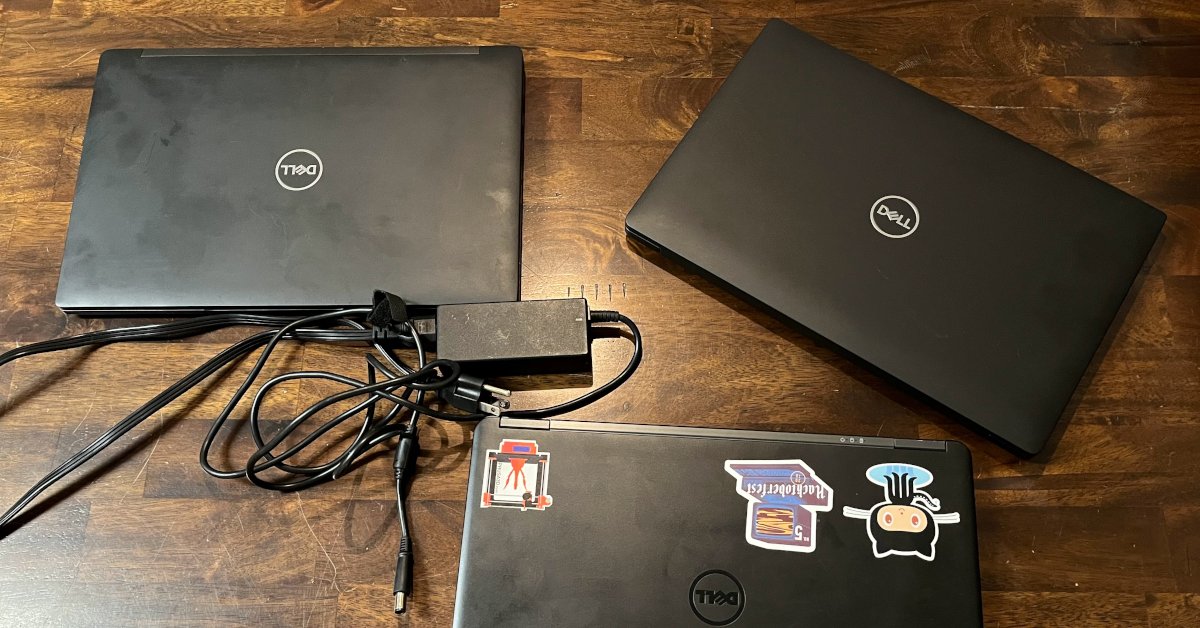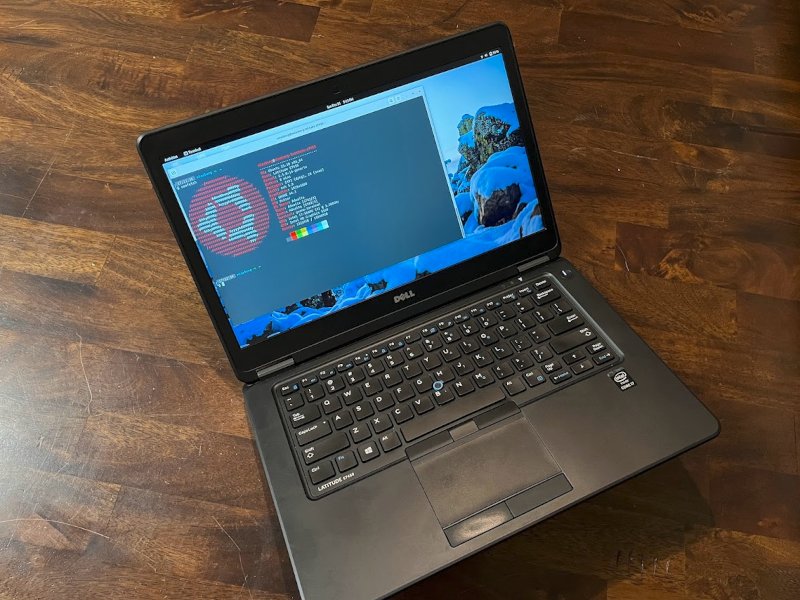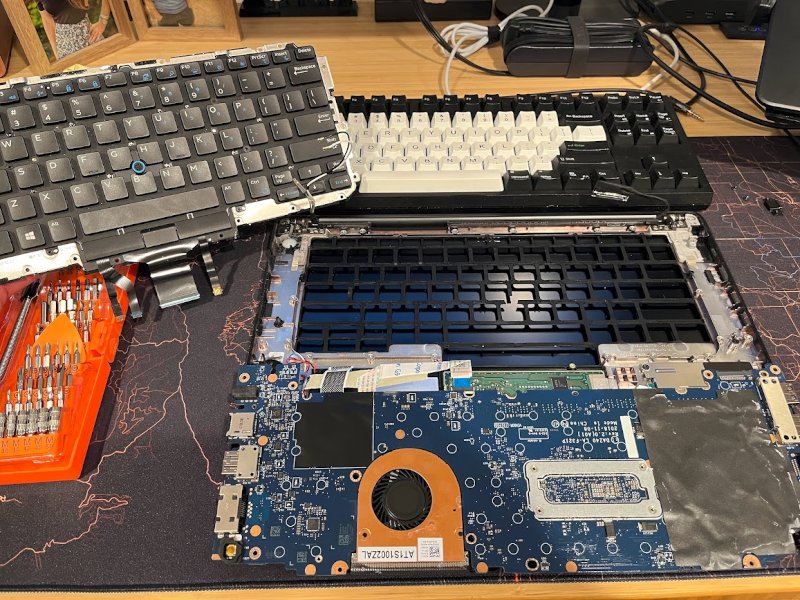
Buying Used Computers: A Story and Some Advice
I’m a big fan of used computers! I often recommend them to friends and relatives, and I’ve bought several myself. I’ve written in the past about the best computer you can buy for $100, my $500 developer laptop, and used Dell Latitudes. But recently, I had a sub-par experience with refurbished computers. Having gone through that, I have some thoughts about the current state of the used computer market and some advice about buying a used computer in 2024.
The Dud
I’ll begin with a story, and this story actually picks up where I left off when buying my $500 developer laptop. I’d ordered a refurbished Latitude 7490 for $436. There was a minor problem getting the right SSD, but I worked it out with the seller and felt happy overall with my purchase. Still, the “refurbished” quality of this computer was pretty poor when I received it. When I installed my new SSD, I noticed that the previous SSD had been installed incorrectly. (It functioned, but was clearly insecure and poor quality workmanship from whoever installed it.) Aside from that, there was a big gash on the back of the computer. The computer was described as follows.
Laptop is in good condition and may only show slight wear from previous use. Overly worn parts such as touchpad and keyboard are replaced entirely. Laptop screen will be free of defects. Laptop has been thoroughly tested and the functionality of all components are guaranteed to be in perfect working order.
Calling the gash on the laptop I received “slight wear from previous use” is a big stretch, but I didn’t complain. I was able to look past it and still felt like I paid a great price for the performance I got – which is what I primarily care about.
I’ve owned that 7490 for several months now, and I’ve been working sporadically to troubleshoot a persistent and annoying problem I was having with the fan in Linux. The fan seemed to run excessively and loudly, even when the computer was cool. I assumed this was a problem with Linux controlling the fan, and I tried a wide variety of solutions like BIOS updates, i8kutils, and other random GitHub repositories for Dell fan control. Nothing seemed to work, and I got really frustrated trying to figure out why. Finally, I figured out the problem using a BIOS diagnostic utility. It found a problem with the fan!

I was actually really happy to see this alert – it meant that my problem was not a software problem with Linux controlling the fan, but was instead a hardware problem with the fan itself! (This was good news because I now understood the problem and why none of my previous solutions worked, so I could figure out how to fix it.) Based on the symptoms, it seemed like the fan was damaged in a way that allowed it to spin but prevented the speed from being properly controlled. The fan would start and stop, but would frequently run at 8K+ RPMs rather than slower, quieter speeds. This wasn’t a problem for performance, but it did make the laptop run very loud.
Though I was happy to understand the problem, I was bummed that it couldn’t be fixed with software. The refurbished computer I’d bought several months earlier had come with a slightly-damaged fan, and I didn’t notice (or at least didn’t correctly diagnose the problem) for more than three months. I could try to return it, but that seemed unlikely given the standard 30-day return policy. So I was left with a 7490 laptop that not only had a bad gash on the back but also a bad fan (possibly damaged at the same time, now that I think about it).
I decided that I didn’t trust this 7490 for long-term use as my personal computer, and though replacing the fan might solve the problem, I didn’t want to dive into that fix without knowing how difficult it would be, how expensive it would get, or what else I would find. I wanted to buy a different computer with a working fan (and hopefully no cosmetic damage either). I considered a few options, including buying a new $1,000+ laptop or a used ThinkPad T480 (as recommended by Max Rozen), but ultimately decided to double down and try buying another Latitude 7490, hopefully with better luck this time.
The Refurbished Market
I’m disappointed with the current state of the computer refurbishing industry and the used computer market in general. Maybe I’ve just been lucky in the past, but back in 2018 I bought a beautiful refurbished e7450 from a seller on Newegg. An i5-5300U with 8GB DDR3, three years old at the time, for $330.

In total, I’ve bought at least five refurbished computers in the last ten years (not all for myself), and this most recent experience with the 7490 was the only bad experience I’ve had. I want refurbished computers to be a great, reliable option, but it doesn’t feel like they are right now.
As I was shopping for a replacement laptop for my slightly-broken 7490, I thought harder about where to shop for a really clean used computer. I’ve had great success with Newegg in the past, but I was disappointed with their selection of 7490s. In the past, I’ve often bought “Grade A” refurbished machines, typically either used very lightly or with replaced keyboards and trackpads, and almost no cosmetic damage. But this time the available selection of refurbished 7490s was either “Grade B” or not even graded. Buying a Grade A laptop (from a reliable seller) feels like getting a great deal on a nearly-new machine with an open box. But buying a Grade B laptop feels more like a crap shoot, buying a mystery machine that definitely has some cosmetic damage, and might or might not have bad cosmetic damage or other problems. Since I didn’t find any Grade A 7490s available on Newegg, I searched some other places.
Ebay’s used computer selection is interesting. I saw some Ebay sellers listing refurbished laptops, very similar to what I found on Newegg. Still, none of the available 7490s with the specs I wanted were marked as Grade A, and I didn’t feel good about buying a B-grade refurbished laptop sight-unseen. But it occurred to me that on Ebay, I didn’t have to. Some Ebay sellers put many refurbished laptops under one listing with a generic picture of a new machine. But other sellers simply list “used” laptops, and the pictures on Ebay are actual pictures of the machine you’re buying. This is great! You can buy a computer with “light cosmetic damage” and understand before you buy it whether it has a scratch, a gash, or a keyboard with all the letters worn off.
There are also other advantages to buying a used computer on Ebay. Dell laptops in particular have a “Service Tag” on a sticker on the bottom of the laptop. You can type the service tag in at Dell Support to get a detailed description of the original system Dell sold. Some listings have pictures of the service tag on the bottom of the laptop, and some sellers even include the service tag in the description. This is an amazing tool for used computer shopping. You can find product details omitted from the listing! Of course, the computers might have been upgraded or modified since they were manufactured at Dell. It’s not uncommon to see a computer that Dell sold with 8GB RAM listed on Ebay with 16GB RAM – but now you know that it probably has non-OEM RAM in it. On the other hand, if the Ebay RAM size matches what was sold by Dell, odds are it’s OEM RAM! And some components are built into the motherboard and can’t be easily changed.
As I was shopping for my replacement 7490, I knew to look for a couple specific configuration options. Dell sells (sold, I guess) the 7490 with an option to upgrade the USB-C port to Thunderbolt 3. They also offer ten different display options with various resolution/camera/touch options, and two different battery sizes. (I know all this because I read Dell’s 7490 Tech Specs while doing research before shopping for this laptop.) Sellers rarely document all these options correctly in their online listing. I’ve even found a couple Ebay listings that were listed very cheaply because the seller seemed unaware of the difference between a baseline 7490 and a 7490 with Thunderbolt 3 and a 60 Whr battery – listing both as simply, “i7-8650U, 8GB DDR4, 256GB SSD”. If sellers don’t know what they’re selling but you do, use that to your advantage! Ultimately, I used Ebay to find a gorgeous 7490 with the configuration I wanted at an incredible price! But sadly I got another dud.
Laptop Repair
The new 7490 I bought seemed almost perfect, but I soon discovered a hidden issue. The keyboard would intermittently miss key presses on some keys. Every key worked, but some keys simply didn’t register if you pressed them too quickly. (Apparently this can sometimes happen after spilling something on the computer.) It was incredibly annoying, and made fast typing nearly impossible. I considered returning the laptop, but decided against it for two reasons. First, it might have been difficult to prove the laptop was defective since the keyboard problem was intermittent. Second, and more importantly, I was now in possession of two Dell 7490s, each with minor but different problems. My Ebay laptop had a pristine chassis and a working fan! It was spotless other than the keyboard problem, and I didn’t want to let go of the laptop knowing it worked flawlessly other than the keyboard. I decided to keep the laptop and combine all the best parts from my two systems. Doing so involved a fairly complex keyboard swap to move the good keyboard into the best chassis, but it was worth it to me! (And it was kind of fun.)

I also rebuilt the system with the bad fan and keyboard – it runs Windows fine, and I plan to sell it on Ebay, but I’ll explicitly call out the known issues with the fan and keyboard. In doing so, I’ll take a hit on the price (selling for less than what I paid), but I just consider that part of the price I paid for the pristine system I put together.
Advice for Buying a Used Laptop in 2024
This whole experience made me realize a few things about the refurbished computer market. First of all, I still think refurbished computers are a great deal, and I’d still buy a Grade A refurbished machine from a reputable seller, even without pictures of the machine I’m buying (as long as it’s returnable). But, for any lower-grade machine, from now on I’ll want to see pictures of the machine I’m actually buying before I buy it. And in any case, I’ll run some diagnostic tests right after getting the machine. I’m tired of people marking beat-up computers as “Grade B Refurbished” without actually doing anything to them besides wiping the drive. I’m tired of not knowing what I’m getting because they sell hundreds of different used computers in varying degrees of “cosmetic damage” under the same listing. As one way for buyers to get more info, I do think service tags and similar serial numbers or labels are an excellent way to validate the original config of used laptops, and I’d prefer to buy from any listing that includes them. I hope it’ll become much more common for sellers and marketplaces to include this kind of info in their listings.
It’s also worth talking about batteries. Rechargeable batteries go bad after several years of use, so you should expect that the battery in any used computer you buy is nearing the end of it’s useful life. Sometimes, you’ll get lucky. Maybe the previous owner only ever used their laptop plugged in and the battery is excellent. More often, you’ll get a battery that holds a 1-hour charge on a good day. Some sellers will show battery health screenshots, which are somewhat reliable but not always exactly correct. Other sellers might replace the battery entirely, which is great if it’s replaced with a new OEM battery and otherwise a bit of a crap shoot. Ultimately, you should either be okay with the idea of a less-than-perfect battery, or be prepared to buy an OEM battery yourself if you get a dud.
Based on everything I learned through this experience, here are some tips for buying a used computer:
-
Decide what you want. I often steer people toward business grade laptops like Dell Latitudes or Lenovo ThinkPads, but anything you want is fine. Most importantly, at this stage, make sure you look at the tech specs for the computer you want to buy and understand all the configurations it was sold with. The last thing you want is to think you’re getting a great deal only to find that you bought a computer with 1366x768 resolution instead of 1080p.
-
Look locally. This is typically a long-shot, but if you can buy used laptops from your work, or your friend’s work, or from your uncle Bob, you can be much more confident in the quality than you would be buying the same thing over the internet. Just make sure you’re buying something you actually want (or getting an amazing deal), and not just buying a relative’s old junk.
-
Check Newegg’s used/refurbished marketplace. I am a little wary of buying refurbished from Newegg, but I’d still start my search there. I still think Newegg has the best search tools (for CPU/RAM/SSD/resolution/etc) and the most accurate listings. This will give you a feel for your price point. I probably wouldn’t buy a B-grade refurbished laptop without photos from Newegg, but I think I’d still buy a Grade A refurbished machine from a highly-rated seller.
-
Check Ebay. Specifically, look for used computers with actual photos of the computer you’re buying. If possible, look for a service tag (or the equivalent from a different manufacturer) and confirm the specs. If you can find something you want on Ebay, with pictures of the actual computer you’re buying, with detailed and accurate specs, at a reasonable price, buy it!
-
Consider combining two broken laptops like I did. This is only a viable option if you’re confident you can work on the laptop hardware (watch a YouTube video first). But you might get a great deal by, for example, buying one laptop with a broken screen and another of the same model with a bad motherboard, but good screen.
-
After receiving your laptop, upgrade the BIOS and drivers, and run some diagnostic tests. Make sure everything works right when you receive it so you can return it if there’s a problem.
I hope that helps you shop for your next new, used computer! Despite my recent troubles with used computers, I found a solution and ended on a good note! (I’m writing this blog post on my reassembled 7490.) And I’ll probably buy more used computers in the future.
About the Author

👋 Hi, I'm Mike! I'm a husband, I'm a father, and I'm a staff software engineer at Strava. I use Ubuntu Linux daily at work and at home. And I enjoy writing about Linux, open source, programming, 3D printing, tech, and other random topics. I'd love to have you follow me on X or LinkedIn to show your support and see when I write new content!
I run this blog in my spare time. There's no need to pay to access any of the content on this site, but if you find my content useful and would like to show your support, buying me a coffee is a small gesture to let me know what you like and encourage me to write more great content!
You can also support me by visiting LinuxLaptopPrices.com, a website I run as a side project.
Related Posts
- The Best Computer You Can Buy For $100 07 May 2022
- Computer Shopping: The Ultimate Developer Laptop 03 May 2019
- My $500 Developer Laptop 09 Sep 2023